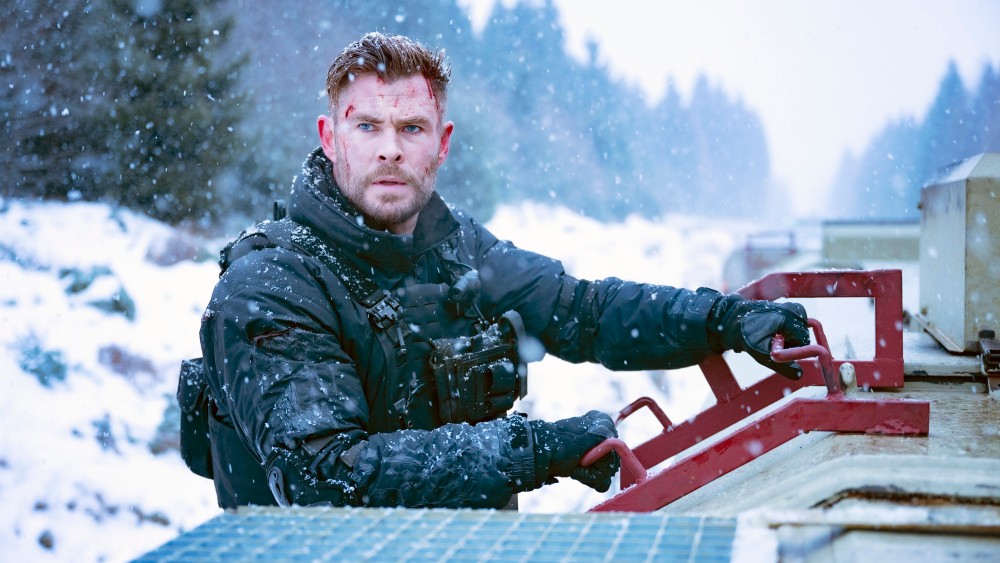‘Extraction 2’ Review: Chris Hemsworth’s Smashing Streaming Sequel
A funny thing happened during our worldwide lockdown in 2020. With theaters shuttered, our immediate movie-going futures looking bleak and escapist entertainment becoming a therapeutic necessity, along came the rise of The Streaming Service Blockbuster — most notably “Extraction.” Stuntman-turned-director Sam Hargrave’s muscular albeit convoluted actioner, centered on a mercenary sent to rescue the kidnapped son of a crime lord, was handed a captive audience. All the folks at home made it a worldwide sensation for Netflix, and it continues to tear up the charts as their seventh most popular film ever (according to their internal, recently-released metrics).
Three years later and armed with a far better, bloody and bruising quest for the laconic hero, Hargrave, star Chris Hemsworth and screenwriter Joe Russo return to the burgeoning franchise with “”. (The graphic novel “Ciudad,” upon which the first film was based, was written by Ande Parks from a story by Parks and the Russo brothers.) The filmmakers’ renewed vigor is our reward as, similar to its unfussy title, this sequel deals in clean-lined action and suspense, removing much of the excessive weight that bogged down the original. As its compelling lead character cuts through his personal strife whilst helping another family find the sense of freedom he too seeks, a new trail is blazed that recenters the series on bone-crunching brutality and bravado.
Our ongoing adventures with Tyler Rake (Hemsworth) pick up right after his previous mission, which left him in a coma with agonizing, life-threatening injuries. After waking, he rehabilitates, in a remote cabin set up by his glamorous handler/ business partner Nik (Golshifteh Farahani) and her ostentatious brother Yaz (Adam Bessa) in the picturesque, snow-covered Austrian wilderness. Though he’s reluctant to accept this forced retirement, he adapts to it quickly, spending the waning hours watching “Dancing With the Stars” with his dog and two chickens and poring over the remains of his past life — mementos of his deceased son tidily packaged in the saddest shoebox ever to grace a cinema screen.
A ray of hope appears for Rake when an International Man of Mystery (Idris Elba, whose character name is deliberately withheld in the film, but the end credits list as Alcott) visits, brandishing a rapier wit and a new extraction assignment for Rake and his crew. They’re tasked to rescue the wife and two kids of incarcerated, abusive drug and arms dealer Davit Radiani (Tornike Bziava) from a decrepit Georgian prison. Trouble is, Davit heads a prolific criminal sect of religious zealots called the Nagazi with his equally unhinged, overly protective brother Zurab (Tornike Gogrichiani), who will stop at nothing in the name of revenge. And, as Rake and his team soon find out, that hellfire of vengeance rains down upon them as a cataclysmic battle ensues.
The original feature had an awe-inducing long take where the camera travelled in, out and around buildings, busy streets and moving vehicles with nary a cut spotted. In this chapter, Hargrave, his camera operators and editors Alex Rodríguez and William Hoy outdo themselves during a gloriously gob-smacking 20-minute oner through a prison riot, desolate woods, a working factory and a moving train attacked by helicopters. The appeal is less about finding where the cuts are hidden, and more about the thrilling spectacle of its execution. From its sound design to the superb stuntwork, this cleverly choreographed and constructed segment keeps audiences riveted with its ballistics and crunching car-cophony.
The baddies’ descent on the skyscraper safe house where Rake and the refugees are holed up is designed like a video game where the objective is to make it out of the building alive. Hargrave and Russo keep multiple plates spinning, having the team splinter to fend off multiple minor bosses before Rake’s penultimate big-boss brawl with Zurab on a glass ledge. Their final face-off combines the narrative’s themes on violence and corruption with a John Woo-inspired aesthetic (complete with an errant pigeon in a chapel). Hemsworth’s performance during these spectacular set pieces keeps character constantly at the forefront of the action — a tricky thing to do, balancing the propulsive speed of the stunts with the emotional drive and mounting intensity. Seeing Farahani actively engaged in shootouts and close-quarters fisticuffs delivers a mood-altering dopamine rush.
Sentiments dealing with grief and illness (either temporary or terminal) give the picture added depth, helping to close one arc for the main character while broadening his future journey toward enlightenment, healing from past trauma. It may appear that the filmmakers have painted themselves into a corner by rectifying Rake’s primary motivator, which directly informed his career ambitions and sense of self. However, leave it to them to find a clever way out – as the final scene suggests by threequel-baiting, setting us up for the next adventure. And the feeling it extracts, at least this time around, is one of satisfaction.

